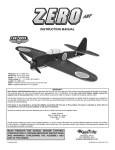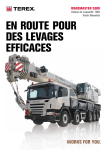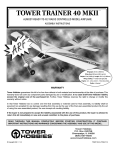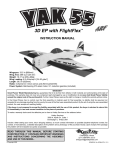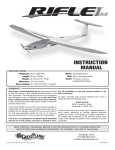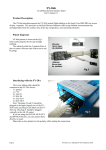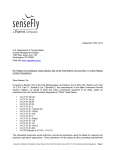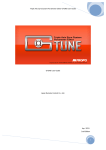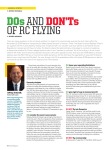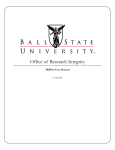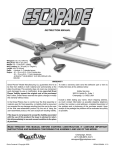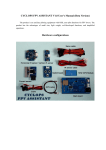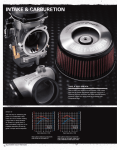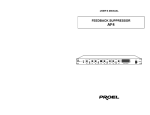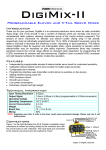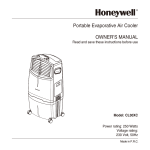Download W ARRANTY Great Planes Model Man ufacturing Co. guarantees
Transcript
WARRANTY Great Planes® Model Manufacturing Co. guarantees this kit to be free from defects in both material and workmanship at the date of purchase. This warranty does not cover any component parts damaged by use or modification. In no case shall Great Planes’ liability exceed the original cost of the purchased kit. Further, Great Planes reserves the right to change or modify this warranty without notice. In that Great Planes has no control over the final assembly or material used for final assembly, no liability shall be assumed nor accepted for any damage resulting from the use by the user of the final user-assembled product. By the act of using the user-assembled product, the user accepts all resulting liability. Champaign, Illinois (217) 398-8970 ext. 5 [email protected] If the buyer is not prepared to accept the liability associated with the use of this product, the buyer is advised to return this kit immediately in new and unused condition to the place of purchase. To make a warranty claim send the defective part or item to Hobby Services at this address. Hobby Services 3002 N. Apollo Dr. Suite 1 Champaign IL 61822 USA Include a letter stating your name, return shipping address, as much contact information as possible (daytime telephone number, fax number, e-mail address), a detailed description of the problem and a photocopy of the purchase receipt. Upon receipt of the package the problem will be evaluated as quickly as possible. AMA We urge you to join the AMA (Academy of Model Aeronautics) and a local R/C club. The AMA is the governing body of model aviation and membership is required to fly at AMA clubs. Though joining the AMA provides many benefits, one of the primary reasons to join is liability protection. Coverage is not limited to flying at contests or on the club field. It even applies to flying at public demonstrations and air shows. Failure to comply with the Safety Code (excerpts printed in the back of the manual) may endanger insurance coverage. Additionally, training programs and instructors are available at AMA club sites to help you get started the right way. There are over 2,500 AMA chartered clubs across the country. Contact the AMA at the address or toll-free phone number below: 5) I will not knowingly operate my model within three miles of any pre-existing flying site except in accordance with the frequency sharing agreement listed [in the complete AMA Safety Code]. 4) I will operate my model using only radio control frequencies currently allowed by the Federal Communications Commission. 3) At all flying sites a straight or curved line(s) must be established in front of which all flying takes place with the other side for spectators. Only personnel involved with flying the aircraft are allowed at or in the front of the flight line. Intentional flying behind the flight line is prohibited. 2) I will not fly my model aircraft in the presence of spectators until I become a qualified flier, unless assisted by an experienced helper. RADIO CONTROL 1) I will have completed a successful radio equipment ground check before the first flight of a new or repaired model. Academy of Model Aeronautics IMPORTANT!!! 5151 East Memorial Drive Two of the most important things you can do to preserve the radio Muncie, IN 47302-9252 controlled aircraft hobby are to avoid flying near full-scale aircraft Tele. (800) 435-9262 and avoid flying near or over groups of people. Fax (765) 741-0057 Or via the Internet at: http://www.modelaircraft.org AMA SAFETY CODE (excerpts) Read and abide by the following excerpts from the Academy of Model Aeronautics Safety Code. For the complete Safety Code refer to Model Aviation magazine, the AMA web site or the Code that came with your AMA license. GENERAL 1) I will not fly my model aircraft in sanctioned events, air shows, or model flying demonstrations until it has been proven to be airworthy by having been previously, successfully flight tested. 2) I will not fly my model aircraft higher than approximately 400 feet within 3 miles of an airport without notifying the airport operator. I will give right-of-way and avoid flying in the proximity of full-scale aircraft. Where necessary, an observer shall be utilized to supervise flying to avoid having models fly in the proximity of full-scale aircraft. 3) Where established, I will abide by the safety rules for the flying site I use, and I will not willfully and deliberately fly my models in a careless, reckless and/or dangerous manner. 5) I will not fly my model unless it is identified with my name and address or AMA number, on or in the model. Note: This does not apply to models while being flown indoors. 7) I will not operate models with pyrotechnics (any device that explodes, burns, or propels a projectile of any kind). 9) Under no circumstances may a pilot or other person touch a powered model in flight; nor should any part of the model other than the landing gear intentionally touch the ground, except while landing. KIT INSPECTION Before starting to build, take an inventory of this kit to make sure it is complete, and inspect the parts to make sure they are of acceptable quality. If any parts are missing or are not of acceptable quality, or if you need assistance with assembly, contact Product Support. Wingspan: 19in [480mm] Wing Area: 109 sq in [7 dm2] Weight: 6.7 oz [190 g] Wing Loading: 8.9 oz/sq ft [27 g/dm2] Length: 15.75in [400mm] Radio: 2-Channel, Two 7-9g servos, Micro Receiver, 5A ESC with BEC. Motor: 180-size motor (40-50W) Great Planes Product Support 3002 N Apollo Drive, Suite 1 Champaign, IL 61822 Telephone: (217) 398-8970, ext. 5 Fax: (217) 398-7721 E-mail: [email protected] TOOLS NEEDED TO FINISH YOUR MODEL Philips screwdriver Foam safe CA or epoxy 2 Pushrods 2 Faslinks 2 Propellers KIT CONTENTS 1 Fuselage with wing 1 Canopy 1 Receiver cover PARTS NEEDED TO FINISH YOUR MODEL 3 channel radio with elevon mixing capabilities Micro receiver (GPML0044 or GPML0045) Short crystal (GPML20**) Two 7-9g servos (FUTM0042) 5A speed control (GPMM2000) 8-Cell 350 mAh NiMH battery (GPMP0067) Failure to follow these safety precautions may result in severe injury to yourself and others. Keep your face and body as well as all spectators away from the plane of rotation of the propeller as you start and run the motor. MOTOR SAFETY PRECAUTIONS Use safety glasses when testing the motor. Keep these items away from the prop: loose clothing, shirt sleeves, ties, scarfs, long hair or loose objects such as pencils or screwdrivers that may fall out of shirt or jacket pockets into the prop. Do not run the motor in an area of loose gravel or sand; the propeller may throw such material in your face or eyes. UPDATES For the latest technical updates or manual corrections to the Great Planes Mini Delta EP visit the Great Planes web site at www.greatplanes.com. Open the “Airplanes” link, then select Mini Delta EP. If there is new technical information or changes to this model a “tech notice” box will appear in the upper left corner of the page. © Copyright 2005 GPMZ0276 for GPMA1172 V1.0 1 Glue the two servos in place with foam safe CA as shown. ASSEMBLY INSTRUCTIONS 2 Install the receiver and the speed control in the fuselage. 4 Center the servos with the radio. Install the servo arms, the pushrods and the faslinks. PREFLIGHT Range Check Ground check the operational range of your radio before the first flight of the day. With the transmitter antenna collapsed and the receiver and transmitter on, you should be able to walk at least 100 feet away from the model and still have control. Charge the Batteries Follow the battery charging instructions that came with your radio control system to charge the transmitter batteries. Do the same for your motor batteries. Identify Your Model No matter if you fly at an AMA sanctioned R/C club site or if you fly somewhere on your own, you should always have your name, address, telephone number and AMA number on or inside your model. It is required at all AMA R/C club flying sites and AMA sanctioned flying events. Make a small hole on the side of the fuselage and slide the receiver antenna through it. Tape the antenna to the leading edge of the wing. 3 5 Install the motor battery, canopy and receiver hatch. Adjust the elevons' neutral point, the throws and the CG. Place the decals on the plane using the photo in the front page as a guide. Go fly! GET THE MODEL READY TO FLY Check the Control Directions 1. With the transmitter and receiver on, check all the control surfaces to see if they are centered. If necessary, adjust the clevises on the pushrods to center the control surfaces. 2. Make certain that the control surfaces and the throttle respond in the correct direction as shown in the diagram. Set the Control Throws 3/8” [9mm] up 3/8” [9mm] down High Rate 3/16” [4.5mm] up 3/16” [4.5mm] down 3/16” [4.5mm] up 3/16” [4.5mm] down Low Rate FULL THROTTLE RIGHT ELEVON MOVES UP LEFT ELEVON MOVES DOWN ELEVONS MOVE UP RADIO SETUP 4-CHANNEL TRANSMITTER 4-CHANNEL TRANSMITTER 4-CHANNEL TRANSMITTER 5.4" [136mm] IMPORTANT: Mini Delta EP has been extensively flown and tested to arrive at the throws at which it flies best. Flying your model at these throws will provide you with the greatest chance for successful first flights. IMPORTANT: For a flying wing to be aerodynamically stable, the neutral position of the elevons needs to be raised from neutral. To achieve pitch stability, place a ruler on the bottom of the wing and adjust the neutral position of the elevons so that the trailing edge of each elevon is raised 3/32” [2mm]. ELEVATOR 3/8” [9mm] up 3/8” [9mm] down These are the recommended control surface throws: AILERONS Balance the Model (C.G.) More than any other factor, the C.G. (balance point) can have the greatest effect on how a model flies, and may determine whether or not your first flight will be successful. If you value this model and wish to enjoy it for many flights, DO NOT OVERLOOK THIS IMPORTANT PROCEDURE. A model that is not properly balanced will be unstable and possibly unflyable. When checking the CG the model should be in ready-to-fly condition with all of the systems in place including the battery. The C.G. is located 5.4” [136mm] back from the fuselage along the leading edge of the wing. Change the location of the motor battery to balance your airplane at that point. FLYING Mini Delta EP is a great-flying model that flies smoothly and predictably. Mini Delta EP does not, however, possess the self-recovery characteristics of a primary R/C trainer and should be flown only by experienced R/C pilots. Takeoff Hold the airplane from the fuselage under the wing and point it slightly “up”. Remember to launch the airplane into the wind. Apply 3/4 to full throttle and launch the plane with moderate force. Flight This plane can fly fast for about 6 minutes when flown at full throttle. The airplane is fast but predictable. Get used to the plane at low rates before switching to high rates as the roll and pitch rates will become extremely quick on high rates. Flight times will increase if throttle management is practiced. The Mini Delta EP can maintain altitude at 1/3 throttle and it can fly most maneuvers at ½. The Mini Delta EP is still stable and predictable at slow speeds and it also allows the pilot more time to think about its reactions. The Mini Delta EP is capable of loops and rolls, inverted flight and any other maneuver that does not require rudder. On high rates, it can also perform some stalling maneuvers like walls. Landing To initiate a landing approach, lower the throttle and let the airplane lose some altitude. When the model is 2-3 feet [60-90 cm] from the ground, apply up elevator to bleed off speed and land while maintaining the same heading. GOOD LUCK AND GREAT FLYING!


